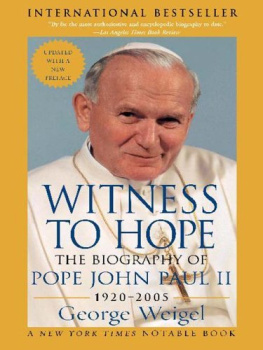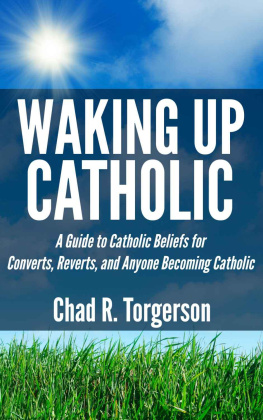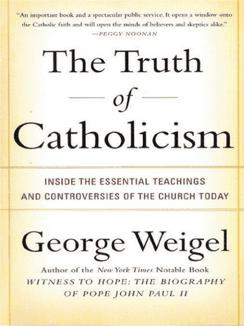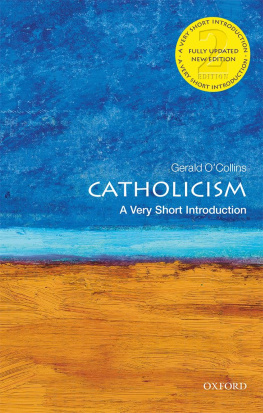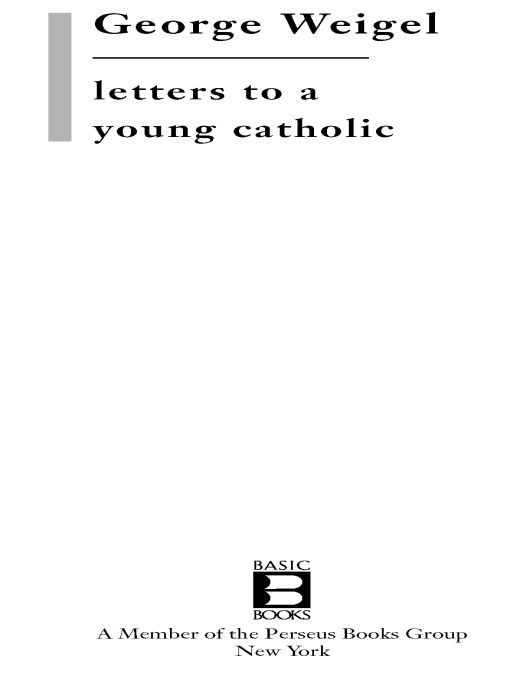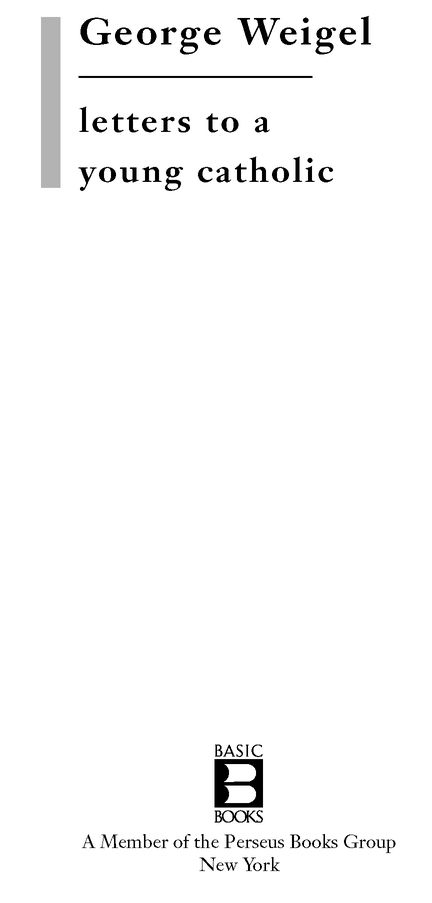Table of Contents
The Art of Mentoring from Basic Books
Letters to a Young Lawyer
Alan Dershowitz
Letters to a Young Contrarian
Christopher Hitchens
Letters to a Young Golfer
Bob Duval
Letters to a Young Conservative
Dinesh DSouza
Letters to a Young Activist
Todd Gitlin
Letters to a Young Therapist
Mary Pipher
Letters to a Young Chef
Daniel Boulud
Letters to a Young Gymnast
Nadia Comaneci
Letters to a Young Catholic
George Weigel
Letters to a Young Actor
Robert Brustein
Also by George Weigel
Gods Choice: Pope Benedict XVI and the Future of the Catholic Church
Cube and the Cathedral: Europe, America, and Politics Without God
The Courage To Be Catholic: Crisis, Reform, and the Future of the Church
Tranquillitas Ordinis: The Present Failure and Future Promise of American Catholic Thought on War and Peace
Catholicism and the Renewal of American Democracy
American Interests, American Purpose: Moral Reasoning and U.S. Foreign Policy
Freedom and Its Discontents: Catholicism Confronts Modernity
Just War and the Gulf War (with James Turner Johnson)
The Final Revolution: The Resistance Church and the Collapse of Communism
Soul of the World: Notes on the Future of Public Catholicism
Witness to Hope: The Biography of Pope John Paul II
The Truth of Catholicism
To
my students in the
Tertio Millennio Seminar on the Free Society
in Liechtenstein and Krakw,
1992-2003
A Preliminary Postcard
These letters are written to, and for, young Catholicsand not-so-young Catholics, and indeed curious souls of any religious persuasion or nonewho wonder what it means to be a Catholic today, at the beginning of the twenty-first century and the third millennium.
There are lots of ways to explore that question. We could take a walk through the Catechism of the Catholic Church, reviewing the key points of Christian doctrine and thinking through the myriad challenges of living a Catholic life today. Or we could ponder the lives of the saints, ancient and modern, and see what their experiences have to offer by way of example and inspiration. We could think together about the sacraments of the Church: what does it mean to be baptized, to celebrate the Mass and receive Christs body and blood in holy communion, to experience the forgiveness of Christ in the sacrament of penance? We could discuss prayer, and its many forms, styles, and methods.
The more I think about it, though, the more it seems to me that the best way to explore the meaning of Catholicism is to take an epistolary tour of the Catholic world, or at least those parts of the Catholic world that have shaped my own understanding of the Church, its people, its teaching, and its way of life. Catholicism is a very tangible businessits about seeing and hearing, touching, tasting, and smelling as much as its about texts and arguments and ideas. Visiting some of the more intriguing parts of the Catholic world will, I hope, be an experience of the mystery of the Church, which is crucial to understanding it. And by the mystery of the Church, I dont mean the documents long filed away in the Vatican Secret Archives. I mean those dimensions of the Catholic experience that are matters of intuition and empathy and insightexperiences that can never be fully captured discursively.
Where to begin our tour? Perhaps a small autobiographical indulgence isnt out of place in a book like this. So lets begin by visiting the Catholic world of my youth. At the very least, its an interesting slice of Americana. I think its more than that, though. When I was a very young Catholic, I absorbed things by a kind of osmosis, things that just may shed light on the fuller and deeper truths of Catholic faith todayeven though were living in a very different time and place and circumstance.
Baltimore and MilledgevilleAcquiring the Habit of Being
I grew up in seemingly the last moment of intact Catholic culture in the United States: the late 1950s and early 1960s in Baltimore, one of the most Catholic cities in the country. There were lots of places like thisBoston, surely; large parts of New York and Philadelphia; Chicago and Milwaukee and St. Louis. Still, there was something distinctive about Catholic Baltimore in those days. American Catholics past and present are notoriously ignorant of the history of the Church in the United States. In Baltimore, we were very much aware that we were living in the first of American dioceses, with the first bishop and the first cathedraland, of course, the Baltimore Catechism, which was used in those days from sea to shining sea.
Catholic Baltimore was different from other parts of Americas urban Catholic culture in degree, not in kind. We didnt divide the world into Baltimore Catholicism and Milwaukee Catholicism (or Philadelphia Catholicism, or New York Catholicism, or Boston Catholicism, or whatever). We quite naturally and unself-consciously divided the world into Catholicspeople we recognized by a kind of instinctand non-Catholics. That instinct wasnt a matter of prejudice. It was the product of a unique experience, and you instinctively recognized people whod been formed by the same experience.
How were we different? To begin with, we had a singular way of describing ourselves. When someone asked us where we were from, we didnt say South Baltimore or Highlandtown or Towson or Catonsville. Wed say Im from Star of the Sea (or St. Elizabeths or Immaculate Conception or St. Agnes, or, in my case, the New Cathedral). Baltimore was (and is) a city of neighborhoods, but in hindsight it seems instructive that we identified ourselves first by parish rather than geographic area. Some might call this tribal, and there were certainly elements of the tribal (especially ethnic tribal) in this distinctive way of telling a stranger who you were. It was a different kind of tribalism, though, a Catholic tribalism that fostered fierce rivalries and even fiercer loyalties: rivalries among parishes and schools and teams and youth groups, but beyond and through all those rivalries, an intense sense of belonging to something larger than ourselves, something beyond ourselves that somehow lived inside us, too. All of which was, as I look back on it, a first inkling of catholicity (which is another word for universality) and its relationship to particularity.
We used a different vocabulary in the Catholic world in which I grew up. With the possible exception of grinds aiming to score 800 on the SAT verbals, the only American kids between the ages of ten and eighteen who regularly used words like vocation, monstrance, missal, crucifer, biretta, chasuble, surplice, ciborium, and paten were Catholics. (This arcane, Latin-derived vocabulary was a source of aggravation to generations of high school and college English composition teachers, eager to get us using short, sharp words of Anglo-Saxon origin rather than those luxurious Latinate nouns and verbs.) We also pronounced words differently: non-Catholics said Saint AW-gus-teen, but we knew it was Saint Uh-GUS-tin. Then there was our sense of identification with some local heroes. Other kids could recite the relevant batting and pitching, passing and receiving statistics of their sports idols, but hadnt a clue (and couldnt have cared less) about their religious affiliation. We were stat crazy, too, but we also knew who the Catholics were (John Unitas, Artie Donovan, Brooks Robinson) and what parish they belonged to. And we sensed a connection to these athletic gods that was... different, somehow.


